From The Center for Grassroots Oversight
http://educate-yourself.org/cn/LeeHamilton21aug06.shtml
August 21, 2006
Profile: Lee Hamilton (August 21, 2006)
Web posted at: : http://www.cooperativeresearch.org/entity.jsp?entity=lee_hamilton
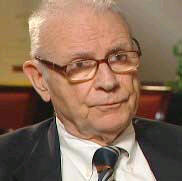
Former 9/11 Commission co-chair Lee Hamilton. [Source: CBC]Lee
Hamilton, the former co-chair
of the 9/11 Commission, gives a wide-ranging interview to the CBC
about Without Precedent, a book he recently co-authored about his
time on the 9/11 Commission (see
August 15, 2006). In the interview he discusses the various “conspiracy
theories” surrounding the events
of 9/11. The interviewer, Evan Solomon, mentions to him a recent
Zogby poll (see
May 17, 2006) that found that 42%
of Americans agreed that “the US government, and its 9/11 Commission,
concealed or refused to investigate critical evidence that contradicts the
official explanation
of September 11th.” Hamilton calls this lack
of trust in the Commission’s report “dispiriting,” but attacks
the “conspiracy theory people,” saying, “when they make an assertion they do
it often
on very flimsy evidence.” He addresses some
of the various “conspiracy theories” that have been put forward about
9/11:
![]() In order to contradict the allegation that the Twin Towers were brought down
deliberately with pre-planted explosives, Hamilton says the WTC collapsed
(see
8:57 a.m. September 11, 2001) because “the super-heated jet fuel melted
the steel super-structure
of these buildings and caused their collapse.” He adds, “There’s a
powerful lot
of evidence to sustain that point
of view, including the pictures
of the airplanes flying into the building.”
In order to contradict the allegation that the Twin Towers were brought down
deliberately with pre-planted explosives, Hamilton says the WTC collapsed
(see
8:57 a.m. September 11, 2001) because “the super-heated jet fuel melted
the steel super-structure
of these buildings and caused their collapse.” He adds, “There’s a
powerful lot
of evidence to sustain that point
of view, including the pictures
of the airplanes flying into the building.”
![]() With regard to the collapse
of WTC Building 7 (see
(5:20 p.m.) September 11, 2001), which some people claim was also caused
by explosives, he argues, “[W]e believe that it was the aftershocks
of these two huge buildings in the very near vicinity collapsing. And
in the Building 7 case, we think that it was a case
of flames setting
off a fuel container, which started the fire in Building 7, and that
was our theory on Building 7.” However, the interviewer points out that the
9/11 Commission’s final report does not actually mention the collapse
of Building 7, and Hamilton says he does not recall whether the
Commission made a specific decision to leave it out.
With regard to the collapse
of WTC Building 7 (see
(5:20 p.m.) September 11, 2001), which some people claim was also caused
by explosives, he argues, “[W]e believe that it was the aftershocks
of these two huge buildings in the very near vicinity collapsing. And
in the Building 7 case, we think that it was a case
of flames setting
off a fuel container, which started the fire in Building 7, and that
was our theory on Building 7.” However, the interviewer points out that the
9/11 Commission’s final report does not actually mention the collapse
of Building 7, and Hamilton says he does not recall whether the
Commission made a specific decision to leave it out.
![]() In reply to a question about why the debris
of Building 7 were moved quickly from the scene without a thorough
investigation, even though nobody died in Building 7 and there was no need
for rescue operations there, Hamilton responds, “You can’t answer every
question when you conduct an investigation.”
In reply to a question about why the debris
of Building 7 were moved quickly from the scene without a thorough
investigation, even though nobody died in Building 7 and there was no need
for rescue operations there, Hamilton responds, “You can’t answer every
question when you conduct an investigation.”
![]() When asked whether Saeed Sheikh sent Mohamed Atta $100,000 for the 9/11 plot
(see
Early August 2001 and
Summer 2001 and before), Hamilton replies, “I don’t know anything about
it.” When the interviewer presses him about whether the Commission
investigated a possible Pakistani Secret Service (ISI) connection to the
attacks, Hamilton replies, “They may have; I do not recall us writing
anything about it in the report. We may have but I don’t recall it.”
When asked whether Saeed Sheikh sent Mohamed Atta $100,000 for the 9/11 plot
(see
Early August 2001 and
Summer 2001 and before), Hamilton replies, “I don’t know anything about
it.” When the interviewer presses him about whether the Commission
investigated a possible Pakistani Secret Service (ISI) connection to the
attacks, Hamilton replies, “They may have; I do not recall us writing
anything about it in the report. We may have but I don’t recall it.”
![]() Asked about Secretary
of Transportation Norman Mineta’s claim that Vice President Dick
Cheney was in the presidential bunker beneath the White House at 9:20 a.m.
on 9/11 (see
(9:20 a.m.) September 11, 2001), almost 40 minutes earlier than the
Commission claimed he had arrived there, Hamilton replies, “I do not
recall.” When pressed, he expands, “Well, we think that Vice President
Cheney entered the bunker shortly before 10 o’clock. And there is a gap
of several minutes there, where we do not really know what the Vice
President really did. There is the famous phone call between the President
and the Vice President. We could find no documentary evidence
of that phone call.”
Asked about Secretary
of Transportation Norman Mineta’s claim that Vice President Dick
Cheney was in the presidential bunker beneath the White House at 9:20 a.m.
on 9/11 (see
(9:20 a.m.) September 11, 2001), almost 40 minutes earlier than the
Commission claimed he had arrived there, Hamilton replies, “I do not
recall.” When pressed, he expands, “Well, we think that Vice President
Cheney entered the bunker shortly before 10 o’clock. And there is a gap
of several minutes there, where we do not really know what the Vice
President really did. There is the famous phone call between the President
and the Vice President. We could find no documentary evidence
of that phone call.”
![]() When the interviewer points out that Richard Clarke’s account conflicts with
the Commission’s over what time authorization was received from Dick Cheney
to shoot down Flight 93 (see
(Between 9:45-9:55 a.m.) September 11, 2001 and
(Between 10:00 a.m.-10:15 a.m.) September 11, 2001), Hamilton retorts,
“Look, you’ve obviously gone through the report with a fine-toothed comb,
you’re raising a lot
of questions—I can do the same thing.”
When the interviewer points out that Richard Clarke’s account conflicts with
the Commission’s over what time authorization was received from Dick Cheney
to shoot down Flight 93 (see
(Between 9:45-9:55 a.m.) September 11, 2001 and
(Between 10:00 a.m.-10:15 a.m.) September 11, 2001), Hamilton retorts,
“Look, you’ve obviously gone through the report with a fine-toothed comb,
you’re raising a lot
of questions—I can do the same thing.”
The interviewer also asks Hamilton whether he has any unanswered questions of his own about 9/11. Hamilton’s response is: “I could never figure out why these 19 fellas did what they did. We looked into their backgrounds. In one or two cases, they were apparently happy, well-adjusted, not particularly religious - in one case quite well-to-do, had a girlfriend. We just couldn’t figure out why he did it. I still don’t know.” [Canadian Broadcasting Corporation, 8/21/2006]
Entity Tags: Saeed Sheikh, World Trade Center, Richard ("Dick") Cheney, Pakistan Directorate for Inter-Services Intelligence, Lee Hamilton, 9/11 Commission, Richard A. Clarke, Mohamed Atta, Norman Mineta
Timeline Tags: Complete 911 Timeline, 9/11 Timeline
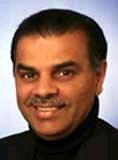
Mansoor Ijaz. [Source: Crescent Hydropolis Resorts
publicity photo]*The
Sudanese government, frustrated in previous efforts to be
removed from a US list
of terrorism sponsors, tries a back channel /approach
using Mansoor Ijaz, a multimillionaire Pakistani-American
businessman. Ijaz is personally acquainted with President
Clinton, National Security Adviser Sandy Berger, and other
high-level US
officials. With help from Ijaz (who is also hoping to
invest in Sudan), on April 5, 1997, Sudan President Omar al-Bashir
writes a letter to Lee Hamilton, the ranking
Democrat on the House Foreign Affairs Committee. It states,
“We extend an offer to the FBI’s Counterterrorism units and any other official elegations Which your government may deem appropriate, to come to the Sudan and work with [us] in order to assess the data in our possession and help us counter the forces your government, and ours, seek to contain.” (*)
* -This is a reference to Sudan’s extensive files on al-Qaeda gathered during the years bin Laden lived there, which the Sudanese had offered the US before (see March 8, 1996-April 1996).
Sudan allows Ijaz to see some of these files. Ijaz discusses the letter with Secretary of State Madeleine Albright, Berger, and other prominent US officials, but to no success. No US official sends any reply back to Sudan.
Tim Carney, US ambassador to Sudan, will complain, “It was an offer US officials did not take seriously.” ABC News will report in 2002 that the 9/11 Congressional Inquiry plans to investigate Sudan’s offer. Sen. Bob Graham (D), co-chairman of the inquiry, will ask, “Why wouldn’t we be accepting intelligence from the Sudanese?”
But the inquiry’s 2003 final report will make no mention of this offer or other offers to hand over the files (see February 5, 1998; May 2000). (It should be noted the report is heavily censored so this might be discussed in redacted sections.) Hamilton, the recipient of the letter, will become the Vice Chairman of the 9/11 Commission. The Commission’s 2004 final report will fail mention Sudan’s offers and will fail to mention the direct involvement of the Commission’s Vice Chairman in these matters. [Vanity Fair, 1/2002; ABC News, 2/20/2002]
Entity Tags: Sandy Berger, Tim Carney, Osama bin Laden, Mansoor Ijaz, Lee Hamilton, Bob Graham, Al-Qaeda, Madeleine Albright, Federal Bureau of Investigation, Omar Al-Bashir
Timeline Tags: Complete 911 Timeline
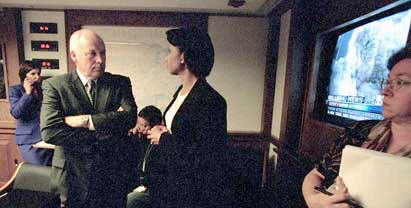
Dick Cheney talking to Condoleezza Rice. [Source: David
Bohrer / White House]According
to a 9/11 Commission staff report, Vice President Cheney is told
that a combat air patrol has been established over Washington.
Cheney then calls President Bush to discuss the rules
of engagement for the pilots. Bush authorizes the
shootdown
of hijacked aircraft at this time. [9/11
Commission, 6/17/2004] According to a Washington Post
article, which places the call after 9:55 a.m., “Cheney
recommended that Bush authorize the military to shoot down any
such civilian airliners—as momentous a decision as the president
was asked to make in those first hours.”
Bush then talks to Defense Secretary Rumsfeld to clarify the procedure, and Rumsfeld passes word down the chain of command. [Washington Post, 1/27/2002] Cheney and Bush recall having this phone call, and National Security Adviser Rice recalls overhearing it. However, as the commission notes, “Among the sources that reflect other important events that morning there is no documentary evidence for this call, although the relevant sources are incomplete. Others nearby who were taking notes, such as the vice president’s chief of staff, [I. Lewis ‘Scooter’] Libby, who sat next to him, and [Lynne] Cheney, did not note a call between the president and vice president immediately after the vice president entered the conference room.”
The commission also apparently concludes that no evidence exists to support the claim that Bush and Rumsfeld talked about such procedures at this time. [9/11 Commission, 6/17/2004] Commission Chairman Thomas Kean says, “The phone logs don’t exist, because they evidently got so fouled up in communications that the phone logs have nothing. So that’s the evidence we have.”
Commission Vice Chairman Lee Hamilton says of the shootdown order, “Well, I’m not sure it was carried out.” [9/11 Commission, 6/17/2004; New York Daily News, 6/18/2004] Newsweek reports that it “has learned that some on the commission staff were, in fact, highly skeptical of the vice president’s account and made their views clearer in an earlier draft of their staff report.
According to one knowledgeable source, some staffers ‘flat out didn’t believe the call ever took place.’” According to a 9/11 Commission staffer, the report “was watered down” after vigorous lobbying from the White House. [Newsweek, 6/20/2004] An account by Canadian Captain Mike Jellinek (who was overseeing NORAD’s Colorado headquarters, where he claims to hear Bush give a shootdown order), as well as the order to empty the skies of aircraft, appears to be discredited. [Toledo Blade, 12/9/2001]
Entity Tags: Mike Jellinek, Richard ("Dick") Cheney, Lee Hamilton, Condoleezza Rice, George W. Bush, 9/11 Commission
Timeline Tags: Complete 911 Timeline, 9/11 Timeline
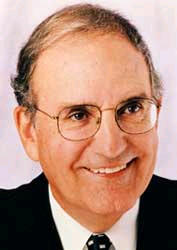 George
Mitchell. [Source: Public domain]George
Mitchell resigns as vice chairman
of the recently-created 9/11 investigative commission.
Lee Hamilton, an Indiana congressman for more
than 30 years and chairman
of the committee which investigated the Iran-Contra
affair, is named as his replacement. [CNN,
12/11/2002] Mitchell cites time constraints as his
reason for stepping down, but he also does not want to sever
ties with his lawyer-lobbying firm, Piper Rudnick, or reveal his
list
of clients. Recent clients include the governments
of Yemen and the United Arab Emirates. [Newsweek,
12/15/2002]
George
Mitchell. [Source: Public domain]George
Mitchell resigns as vice chairman
of the recently-created 9/11 investigative commission.
Lee Hamilton, an Indiana congressman for more
than 30 years and chairman
of the committee which investigated the Iran-Contra
affair, is named as his replacement. [CNN,
12/11/2002] Mitchell cites time constraints as his
reason for stepping down, but he also does not want to sever
ties with his lawyer-lobbying firm, Piper Rudnick, or reveal his
list
of clients. Recent clients include the governments
of Yemen and the United Arab Emirates. [Newsweek,
12/15/2002]
Entity Tags: Lee Hamilton, United Arab Emirates, Yemen, 9/11 Commission, George Mitchell
Timeline Tags: Complete 911 Timeline, 9/11 Timeline
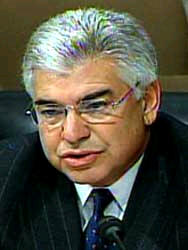
Richard Ben-Veniste. [Source: C-SPAN]The
ten members
of the new 9/11 Commission are appointed by this date,
and are: Republicans Thomas Kean (Chairman), Slade Gorton, James
Thompson, Fred Fielding, and John Lehman, and Democrats
Lee Hamilton (Vice Chairman), Max Cleland, Tim Roemer,
Richard Ben-Veniste, and Jamie Gorelick. [Chicago
Tribune, 12/12/2002;
Associated Press, 12/16/2002;
New York Times, 12/17/2002] Senators Richard Shelby
(R) and John McCain (R) had a say in the choice
of one
of the Republican positions. They and many 9/11 victims’
relatives wanted former Senator Warren Rudman (R), who cowrote
an acclaimed report about terrorism before 9/11. But Senate
Republican leader Trent Lott blocks Rudman’s appointment and
chooses John Lehman instead. [St.
Petersburg Times, 12/12/2002;
Associated Press, 12/13/2002;
Reuters, 12/16/2002]
It
slowly emerges over the next several months that at least
six
of the ten commissioners have ties to the airline
industry. [CBS
News, 3/5/2003] Henry Kissinger (see
December 13, 2002) and his replacement Thomas Kean (see
December 16, 2002) both caused controversy when they were
named. In addition, the other nine members
of the commission are later shown to all have potential
conflicts
of interest. Republican commissioners:
![]() Fred Fielding also works for a law firm lobbying for Spirit
Airlines and United Airlines. [Associated
Press, 2/14/2003;
CBS News, 3/5/2003]
Fred Fielding also works for a law firm lobbying for Spirit
Airlines and United Airlines. [Associated
Press, 2/14/2003;
CBS News, 3/5/2003]
![]() Slade Gorton has close ties to Boeing, which built all the
planes destroyed on 9/11, and his law firm represents several
major airlines, including Delta Airlines. [Associated
Press, 12/12/2002;
CBS News, 3/5/2003]
Slade Gorton has close ties to Boeing, which built all the
planes destroyed on 9/11, and his law firm represents several
major airlines, including Delta Airlines. [Associated
Press, 12/12/2002;
CBS News, 3/5/2003]
![]() John Lehman, former secretary
of the Navy, has large investments in Ball Corp., which
has many US military contracts. [Associated
Press, 3/27/2003]
John Lehman, former secretary
of the Navy, has large investments in Ball Corp., which
has many US military contracts. [Associated
Press, 3/27/2003]
![]() James Thompson, former Illinois governor, is the head
of a law firm that lobbies for American Airlines, and he
has previously represented United Airlines. [Associated
Press, 1/31/2003;
CBS News, 3/5/2003] Democratic commissioners:
James Thompson, former Illinois governor, is the head
of a law firm that lobbies for American Airlines, and he
has previously represented United Airlines. [Associated
Press, 1/31/2003;
CBS News, 3/5/2003] Democratic commissioners:
![]() Richard Ben-Veniste represents Boeing and United Airlines.
[CBS
News, 3/5/2003] Ben-Veniste also has other curious
connections, according to a 2001 book on CIA ties to drug
running written by Daniel Hopsicker, which has an entire chapter
called “Who is Richard Ben-Veniste?” Lawyer Ben-Veniste,
Hopsicker says, “has made a career
of defending political crooks, specializing in cases that
involve drugs and politics.” Ben-Veniste has been referred to in
print as a “Mob lawyer,” and was a long-time lawyer for Barry
Seal, one
of the most famous drug dealers in US history who also is
alleged to have had CIA connections. [Hopsicker,
2001, pp. 325-30]
Richard Ben-Veniste represents Boeing and United Airlines.
[CBS
News, 3/5/2003] Ben-Veniste also has other curious
connections, according to a 2001 book on CIA ties to drug
running written by Daniel Hopsicker, which has an entire chapter
called “Who is Richard Ben-Veniste?” Lawyer Ben-Veniste,
Hopsicker says, “has made a career
of defending political crooks, specializing in cases that
involve drugs and politics.” Ben-Veniste has been referred to in
print as a “Mob lawyer,” and was a long-time lawyer for Barry
Seal, one
of the most famous drug dealers in US history who also is
alleged to have had CIA connections. [Hopsicker,
2001, pp. 325-30]
![]() Max Cleland, former US senator, has received $300,000 from the
airline industry. [CBS
News, 3/5/2003]
Max Cleland, former US senator, has received $300,000 from the
airline industry. [CBS
News, 3/5/2003]
![]() James Gorelick is a director
of United Technologies, one
of the Pentagon’s biggest defense contractors and a
supplier
of engines to airline manufacturers. [Associated
Press, 3/27/2003]
James Gorelick is a director
of United Technologies, one
of the Pentagon’s biggest defense contractors and a
supplier
of engines to airline manufacturers. [Associated
Press, 3/27/2003]
![]() Lee Hamilton sits on many advisory boards,
including those to the CIA, the president’s Homeland
Security Advisory Council, and the US Army. [Associated
Press, 3/27/2003]
Lee Hamilton sits on many advisory boards,
including those to the CIA, the president’s Homeland
Security Advisory Council, and the US Army. [Associated
Press, 3/27/2003]
![]() Tim Roemer represents Boeing and Lockheed Martin. [CBS
News, 3/5/2003]
Tim Roemer represents Boeing and Lockheed Martin. [CBS
News, 3/5/2003]
Entity Tags: Fred Fielding, James Thompson, John Lehman, American Airlines, Jamie Gorelick, Lee Hamilton, John McCain, Max Cleland, Slade Gorton, Richard Shelby, 9/11 Commission, United Airlines, Warren Rudman, Tim Roemer, Trent Lott, Richard Ben-Veniste
Timeline Tags: Complete 911 Timeline, 9/11 Timeline
The 9/11 Commission, officially titled the National Commission on Terrorist Attacks Upon the United States, holds its first meeting in Washington. The commission has $3 million and only a year and a half to explore the causes of the attacks. By comparison, a 1996 federal commission to study legalized gambling was given two years and $5 million. [Associated Press, 1/27/2003] Two months later the Bush administration grudgingly increases the funding to $12 million total (see March 26, 2003). Philip Zelikow, the director of the Miller Center of Public Affairs at the University of Virginia and formerly in the National Security Council during George H. W. Bush’s administration, is also appointed executive director of the commission. [Associated Press, 1/27/2003] Zelikow cowrote a book with National Security Adviser Rice and was also, in 2002, responsible for completely rewriting President Bush’s national security strategy. [9/11 Commission, 3/2003; Mann, 2004, pp. 316-317]
A few days later, Vice Chairman Lee Hamilton says, “The focus of the commission will be on the future. We want to make recommendations that will make the American people more secure.… We’re not interested in trying to assess blame, we do not consider that part of the commission’s responsibility.” [United Press International, 2/6/2003]
Entity Tags: 9/11 Commission, Bush administration, Lee Hamilton, Philip Zelikow
Timeline Tags: Complete 911 Timeline, 9/11 Timeline
In a book published in 2006, 9/11 Commission Chairman Tom Kean and Vice-Chairman Lee Hamilton will say that 9/11 mastermind Khalid Shaikh Mohammed (KSM) is captured “in an early 2003 raid on a Karachi apartment orchestrated by the CIA, the FBI, and Pakistani security services.” [Kean and Hamilton, 2006, pp. 115] Pakistan and the US will announce the arrest at the beginning of March (see March 1, 2003). In contrast to the version put forward later by Kean and Hamilton, the Pakistani government initially states he is captured in a house in Rawalpindi, solely by Pakistani security forces. The US agrees on the date and place, but says it was a joint operation. [CNN, 3/2/2003; Dawn (Karachi), 3/2/2003] However, the initial account is called into question due to various problems (see March 10, 2003). It is unclear whether Kean and Hamilton realize that the passing reference in their book is at variance with the initial account.
Entity Tags: Thomas Kean, Lee Hamilton, Khalid Shaikh Mohammed
Timeline Tags: Complete 911 Timeline, 9/11 Timeline
It is reported that “most members” of the 9/11 Commission still have not received security clearances. [Washington Post, 3/27/2003] For instance, Slade Gorton, picked in December 2002, is a former senator with a long background in intelligence issues. Fellow commissioner Lee Hamilton says, “It’s kind of astounding that someone like Senator Gorton can’t get immediate clearance. It’s a matter we are concerned about.” The commission is said to be at a “standstill” because of the security clearance issue, and cannot even read the classified findings of the previous 9/11 Congressional Inquiry. [Seattle Times, 3/12/2003]
Entity Tags: 9/11 Commission, Slade Gorton, Lee Hamilton, 9/11 Congressional Inquiry
Timeline Tags: Complete 911 Timeline, 9/11 Timeline
The 9/11 Commission holds its first three
hearings in the spring and summer
of 2003 on topics such as the experience
of the attack, congressional oversight, and whether Iraq
was behind 9/11 (see
March 31, 2003). [9/11
Commission, 4/1/2003;
9/11 Commission, 5/23/2003;
9/11 Commission, 7/9/2003 ![]() ]
These hearings do not receive much publicity and Commission
Chairman Tom Kean and Vice-chairman Lee Hamilton
will later call them “background policy hearings in front
of a C-SPAN audience.” The victims’ families are
frustrated by this, by the lack
of tough questioning, and by the fact that witnesses are
not placed under oath. Kean and Hamilton later say that at this
point the Commission “was not ready to present findings and
answers” since the various staff teams are nowhere near
completing their tasks. For example, the team investigating the
air defense failure on the day
of 9/11 does not even issue a subpoena for the documents
it needs until autumn (see
Late October 2003 and
October-November 2003). [Kean
and Hamilton, 2006, pp. 127-8]
]
These hearings do not receive much publicity and Commission
Chairman Tom Kean and Vice-chairman Lee Hamilton
will later call them “background policy hearings in front
of a C-SPAN audience.” The victims’ families are
frustrated by this, by the lack
of tough questioning, and by the fact that witnesses are
not placed under oath. Kean and Hamilton later say that at this
point the Commission “was not ready to present findings and
answers” since the various staff teams are nowhere near
completing their tasks. For example, the team investigating the
air defense failure on the day
of 9/11 does not even issue a subpoena for the documents
it needs until autumn (see
Late October 2003 and
October-November 2003). [Kean
and Hamilton, 2006, pp. 127-8]
Entity Tags: 9/11 Commission, Thomas Kean, Lee Hamilton
Timeline Tags: Complete 911 Timeline, 9/11 Timeline
Several months into its investigation, the 9/11 Commission is already dissatisfied with the Department of Defense (see July 8, 2003). When its staff take a tour of a Northeast Air Defense Sector facility in Rome, New York, which helped coordinate the air defense on the day of 9/11, the staff enter the operations room, which has “more than twenty banks of operators: some weapons controllers and some flight controllers.”
The staff find that the operators’ conversations are always tape-recorded, but the tapes for 9/11 have not yet been sent to the commission and, according to Commission Chairman Tom Kean and Vice-Chairman Lee Hamilton, “there were also discrepancies between things NORAD was telling [the commission] about their performance on the morning of September—things that the agency had stated publicly after 9/11—and the story told by the limited tapes and documents the commission had received.”
Upon learning of the existence of the tapes, team leader John Farmer immediately suspends the tour and the interviews and flies to meet Kean in New Jersey. The commission subsequently subpoenas NORAD for the tapes (see October-November 2003), but, according to Kean and Hamilton, this means that “the staff had lost so much time that our hearing on the 9/11 story in the skies was postponed for months. Indeed, the delays from NORAD and the FAA made it highly unlikely that the team could complete its work as scheduled.” [Kean and Hamilton, 2006, pp. 85-88] Chapter 1 of the commission’s final report will draw heavily on the tapes. [9/11 Commission, 7/24/2004, pp. 1-46]
However, the commission does not make the same effort with all day of 9/11 recordings. For example, it does not even find out which person(s) from the Department of Defense participated in a White House video conference chaired by counter-terrorism “tsar” Richard Clarke during the attacks. [9/11 Commission, 7/24/2004, pp. 36]
Entity Tags: Thomas Kean, Lee Hamilton, Northeast Air Defense Sector, John Farmer, 9/11 Commission
Timeline Tags: Complete 911 Timeline, 9/11 Timeline
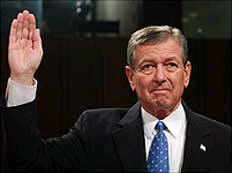
Attorney General John Ashcroft
before the 9/11 Commission. [Source: Associated Press]Attorney
General John Ashcroft
publicly testifies before the 9/11 Commission, claims there was
no program to kill Osama bin Laden before 9/11, and blames the
“wall” (see
July 19, 1995) for the 9/11 attacks. Ashcroft
says, “Let me be clear: my thorough review revealed no covert
action program to kill bin Laden.” However, the 9/11 Commission
has already found a Memorandum
of Notification signed by President Clinton in 1998 after
the embassy bombings that allowed CIA assets to kill bin Laden,
and two commissioners, Fred Fielding and Richard Ben-Veniste,
point this out to Ashcroft.
[9/11
Commission, 4/13/2004;
9/11 Commission, 7/24/2004, pp. 132, 485]
The attorney general comments, “The single greatest structural cause for September 11 was the ‘wall’ that segregated criminal investigators and intelligence agents. Government erected this ‘wall.’ Government buttressed this ‘wall.’ And before September 11, government was blinded by this ‘wall.’”
The wall was a set of procedures that regulated the passage of information from FBI intelligence agents to FBI criminal agents and prosecutors to ensure that information obtained using warrants under the Foreign Intelligence Surveillance Act (FISA) would not be thrown out from criminal cases (see July 19, 1995). Ashcroft says that the wall impeded the investigation of Zacarias Moussaoui and that a “warrant was rejected because FBI officials feared breaching the ‘wall.’” (Note: two applications to search Moussaoui’s belongings were prepared. The first was not submitted because it was thought to be “shaky” (see August 21, 2001). The second warrant application was prepared as a part of an intelligence investigation under the Foreign Intelligence Surveillance Act, so it was not affected by the “wall” (see August 28, 2001)).
According to Ashcroft, the wall also impeded the search for hijackers Khalid Almihdhar and Nawaf Alhazmi because criminal investigators were not allowed to join in. However, the 9/11 Commission will find that they could legally have helped, but were prevented from doing so by FBI headquarters (see August 29, 2001). Ashcroft asserts that 9/11 Commissioner Jamie Gorelick was responsible for the wall.
He cites a document he just declassified that had been written by Gorelick to deal with the two 1993 WTC bombing cases (see March 4, 1995). That document becomes known as the “wall memo.” However, this memo only governed the two WTC cases; all other cases were governed by a different, but similar memo written by Attorney General Janet Reno a few months later (see July 19, 1995). [9/11 Commission, 4/13/2004]
9/11 Commission chairmen Thomas Kean and Lee Hamilton will say that the “attorney general’s claim was overstated,” and that the two 1995 memos only codified a set of procedures that already existed (see Early 1980s). During questioning, Republican 9/11 Commissioner Slade Gorton points out that Ashcroft’s deputy reaffirmed the procedures in an August 2001 memo that stated, “The 1995 procedures remain in effect today” (see August 6, 2001). [Kean and Hamilton, 2006, pp. 194-6]
Entity Tags: Richard Ben-Veniste, Slade Gorton, Zacarias Moussaoui, Thomas Kean, Nawaf Alhazmi, Khalid Almihdhar, 9/11 Commission, Foreign Intelligence Surveillance Act, John Ashcroft, Fred Fielding, Lee Hamilton
Timeline Tags: Complete 911 Timeline, 9/11 Timeline
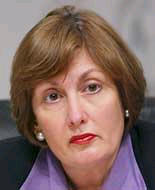
9/11 Commissioner Jamie Gorelick was attacked for
her role in extending the ‘wall’. [Source: Associated
Press / Charles Dharapak]Attorney
General John Ashcroft’s
testimony before the 9/11 Commission (see
April 13, 2004) sparks a wave
of attacks against 9/11 Commissioner Jamie Gorelick, who
was Deputy Attorney General during the Clinton administration.
In 1995 Gorelick played a leading role in extending the “wall,”
a set
of procedures that regulated the passage
of information from FBI intelligence agents to FBI
criminal agents and prosecutors (see
March 4, 1995 and
July 19, 1995). Ashcroft
calls the wall “the single greatest structural cause for
September 11.” The attacks include
![]() On April 14 James Sensenbrenner, chairman
of the House Judiciary Committee, calls on Gorelick to
resign because
of her “crippling conflict
of interest.” He says “the public cannot help but ask
legitimate questions about her motives” and argues that the
commission will be “fatally damaged” if she continues. Other
Republican congresspersons repeat this call;
On April 14 James Sensenbrenner, chairman
of the House Judiciary Committee, calls on Gorelick to
resign because
of her “crippling conflict
of interest.” He says “the public cannot help but ask
legitimate questions about her motives” and argues that the
commission will be “fatally damaged” if she continues. Other
Republican congresspersons repeat this call;
![]() On April 16 House Majority Leader Tom Delay writes to Commission
Chairman Tom Kean saying Gorelick has a conflict
of interest and accusing the commission
of “partisan mudslinging, circus-atmosphere pyrotechnics,
and gotcha-style questioning,” as well as undermining the war
effort and endangering the troops;
On April 16 House Majority Leader Tom Delay writes to Commission
Chairman Tom Kean saying Gorelick has a conflict
of interest and accusing the commission
of “partisan mudslinging, circus-atmosphere pyrotechnics,
and gotcha-style questioning,” as well as undermining the war
effort and endangering the troops;
![]() Criticism
of Gorelick also appears in several media publications,
including the New York Times, New York Post, National Review,
Washington Times, and Wall Street Journal. For example, an op-ed
piece published in the New York Times by former terrorism
commissioners Juliette Kayyem and Wayne Downing says the
commissioners are talking too much and should “shut up.” [National
Review, 4/13/2004;
National Review, 4/19/2004;
Kean and Hamilton, 2006, pp. 200-203]
Criticism
of Gorelick also appears in several media publications,
including the New York Times, New York Post, National Review,
Washington Times, and Wall Street Journal. For example, an op-ed
piece published in the New York Times by former terrorism
commissioners Juliette Kayyem and Wayne Downing says the
commissioners are talking too much and should “shut up.” [National
Review, 4/13/2004;
National Review, 4/19/2004;
Kean and Hamilton, 2006, pp. 200-203]
![]() On April 22 Senator Christopher Boyd and ten other Republican
senators write to the commission calling on Gorelick to testify
in public;
On April 22 Senator Christopher Boyd and ten other Republican
senators write to the commission calling on Gorelick to testify
in public;
![]() On April 26 Congressman Lamar Smith and 74 other Republicans
write to Gorelick demanding answers to five questions about her
time as deputy attorney general;
On April 26 Congressman Lamar Smith and 74 other Republicans
write to Gorelick demanding answers to five questions about her
time as deputy attorney general;
![]() On April 28 the
Justice Department declassifies other memos signed by
Gorelick;
On April 28 the
Justice Department declassifies other memos signed by
Gorelick;
![]() In addition to hate mail, Gorelick receives a bomb threat,
requiring a bomb disposal squad to search her home.
In addition to hate mail, Gorelick receives a bomb threat,
requiring a bomb disposal squad to search her home.
Commission Chairmen Tom Kean and Lee Hamilton
will call this an “onslaught” and say her critics used the
wall “as a tool to bludgeon Jamie Gorelick, implicate the
Clinton administration, and undermine the credibility
of the commission before we had even issued our report.”
Gorelick
offers to resign, but the other commissioners support her
and she writes a piece for the Washington Post defending
herself. [Washington
Post, 4/18/2004;
Kean and Hamilton, 2006, pp. 200-205]
When the commission meets President Bush and Vice President Cheney at the end of the month (see April 29, 2004), Bush tells Kean and Hamilton he does not approve of memos being declassified and posted on the Justice Department’s website. At this point, the commissioners realize “the controversy over Jamie Gorelick’s service on the commission was largely behind us.” That afternoon, the White House publicly expresses the president’s disappointment over the memos and the effort to discredit Gorelick loses momentum. [Kean and Hamilton, 2006, pp. 208, 210]
Entity Tags: Lamar Smith, Tom DeLay, Thomas Kean, Lee Hamilton, Juliette Kayyem, Jamie Gorelick, George W. Bush, Andrew McCarthy, Christopher Boyd, Foreign Intelligence Surveillance Act, John Ashcroft, Wayne Downing
Timeline Tags: Complete 911 Timeline, 9/11 Timeline
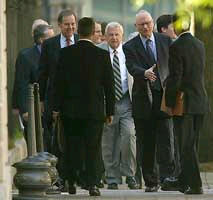 There were no pictures
allowed
of the Bush and Cheney joint testimony before the 9/11
Commission. Here are Commissioners Thomas Kean, Fred Fielding,
and Lee Hamilton preparing to begin the testimony. [Source:
New York Times]President Bush
and Vice President Cheney appear for three hours
of private questioning before the 9/11 Commission.
(Former President Clinton and former Vice President Al Gore met
privately and separately with the commission earlier in the
month. [Washington
Post, 4/30/2004;
New York Times, 4/30/2004] )
There were no pictures
allowed
of the Bush and Cheney joint testimony before the 9/11
Commission. Here are Commissioners Thomas Kean, Fred Fielding,
and Lee Hamilton preparing to begin the testimony. [Source:
New York Times]President Bush
and Vice President Cheney appear for three hours
of private questioning before the 9/11 Commission.
(Former President Clinton and former Vice President Al Gore met
privately and separately with the commission earlier in the
month. [Washington
Post, 4/30/2004;
New York Times, 4/30/2004] )
The commission permits Bush and Cheney to appear together, in private, and not under oath. The testimony is not recorded. Commissioners can take notes, but the notes are censored by the White House. [Knight Ridder, 3/31/2004; Newsweek, 4/2/2004; New York Times, 4/3/2004]
The commission drew most of their questions from a list submitted to the White House before the interview, but few details about the questions or the answers given are available. [Washington Post, 4/29/2004]
Two commissioners, Lee Hamilton and Bob Kerrey, leave the session early for other engagements. They claim they had not expected the interview to last more than the previously agreed upon two-hour length. [New York Times, 5/1/2004]
Entity Tags: Lee Hamilton, 9/11 Commission, Bob Kerrey, Richard ("Dick") Cheney, George W. Bush
Timeline Tags: Complete 911 Timeline, 9/11 Timeline
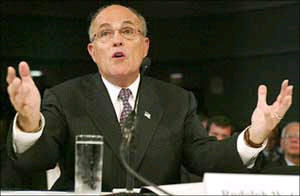
Rudy Giuliani testifying before the 9/11 Commission.
[Source: Gotham Gazette]The
first day
of the 9/11 Commission’s eleventh public hearing in New
York produces an adverse reaction in the New York press, due to
questioning
of former city
officials by Commissioner John Lehman. The second day is
begun by former New York Mayor Rudy Giuliani, whose opening
statement draws considerable applause from the audience and who
won Time magazine’s Person
of the Year award for 2001. [Time,
12/22/2001;
Kean and Hamilton, 2006, pp. 226-228]
According to Commission Chairman Thomas Kean and Co-chairman
Lee Hamilton, “Each commissioner opens his or
her questioning with lavish praise.”
For instance, Richard Ben-Veniste: “Your leadership on that day and in the days following gave the rest of the nation, and indeed the world, an unvarnished view of the indomitable spirit and the humanity of this great city, and for that I salute you.”
Jim Thompson thanks him for “setting an example to us all.”
John Lehman: “There was no question the captain was on the bridge.”
Kean: “New York City on that terrible day in a sense was blessed because it had you as a leader.”
This draws a mixed reaction from the audience, some of whom support Giuliani and some of whom want “real questions.” Kean and Hamilton will later say that: “The questioning of Mayor Giuliani was a low point in terms of the commission’s questioning of witnesses at our public hearings. We did not ask tough questions, nor did we get all of the information we needed to put on the public record. We were affected by the controversy over Lehman’s comments, and by the excellent quality of the mayor’s presentation.” [Kean and Hamilton, 2006, pp. 228-231]
Entity Tags: Richard Ben-Veniste, Thomas Kean, Rudolph ("Rudy") Giuliani, James Thompson, John Lehman, Lee Hamilton
Timeline Tags: Complete 911 Timeline, 9/11 Timeline
Former leaders of the 9/11 Commission, Thomas Kean and Lee Hamilton, release a statement saying that panel staff members have found no documents or other witnesses that support allegations that hijacker Mohamed Atta was identified by a secret Pentagon program, known as Able Danger, before the 9/11 attacks.
The existence
of Able Danger first received wide public attention a few
days before by the New York Times (see
August 11, 2005). According to the commissioners, “The
interviewee had no documentary evidence” to back up his claims
and “the Commission staff concluded that the
officer’s account was not sufficiently reliable to
warrant revision
of the report or further investigation.” [Thomas
H. Kean and Lee H. Hamilton, 8/12/2005 ![]() ;
Washington Post, 8/13/2005]
;
Washington Post, 8/13/2005]
Entity Tags: Thomas Kean, Lee Hamilton
Timeline Tags: Complete 911 Timeline, 9/11 Timeline
A new version of a report by the 9/11 Commission on the FAA and 9/11, which was completed in August 2004, is publicly released. A heavily censored version of the same report came out in February 2005 (see February 10, 2005). Commission members complained that the deleted material included information crucial to understanding what went wrong on 9/11.
The newly released version restores dozens of portions of the report, but numerous references to shortcomings in aviation security remain blacked out. Thomas Kean and Lee Hamilton, the former heads of the 9/11 Commission, state: “While we still believe that the entire document could be made available to the public without damaging national security, we welcome this step forward.” Commission officials say they were perplexed by the White House’s original attempts to black out material that they considered trivial or mundane. [Associated Press, 9/13/2005; New York Times, 9/14/2005]
Entity Tags: 9/11 Commission, Lee Hamilton, Thomas Kean, Federal Aviation Administration
Timeline Tags: Complete 911 Timeline, 9/11 Timeline
Thomas Kean and Lee Hamilton, the former chairman and vice chairman of the 9/11 Commission, release a book giving a behind-the-scenes look at their 20-month investigation of the September 11 attacks. [Associated Press, 8/4/2006] They begin their book, titled Without Precedent, saying that, because their investigation started late, had a very short time frame, and had inadequate funding, they both felt, from the beginning, that they “were set up to fail.” [Canadian Broadcasting Corporation, 8/21/2006; Rocky Mountain News, 8/25/2006]
They explain the difficulties they faced in obtaining certain government documents and describe how the commission almost splintered over whether to investigate the Bush administration’s use of 9/11 as a reason for going to war.
It says that if original member Max Cleland—a strong proponent of this line of inquiry—had not resigned (see December 9, 2003), the commission probably would not have reached unanimity. It also calls their gentle questioning of former New York Mayor Rudolph Giuliani during his May 2004 testimony, “a low point” in the commission’s handling of witnesses at its public hearings (see May 19, 2004). [Associated Press, 8/4/2006; New York Daily News, 8/5/2006; New York Times, 8/6/2006]
Despite the problems it faced, when discussing his book with the CBC, Hamilton says he thinks the commission has “been reasonably successful in telling the story” of 9/11.
[Canadian Broadcasting Corporation, 8/21/2006] Without Precedent, however, contains little new information about the events of 9/11. Intelligence expert James Bamford says there is “an overabundance of self-censorship by the authors.” [New York Times, 8/20/2006]